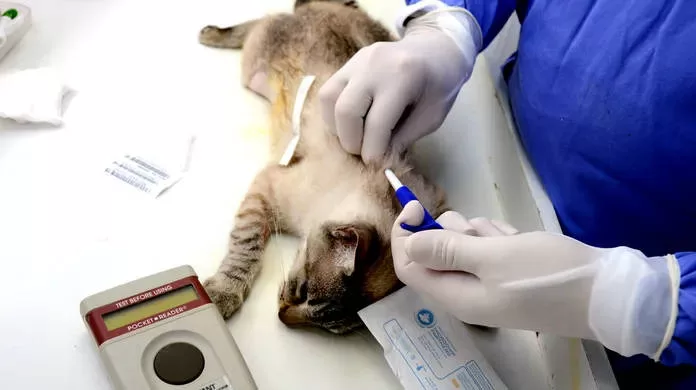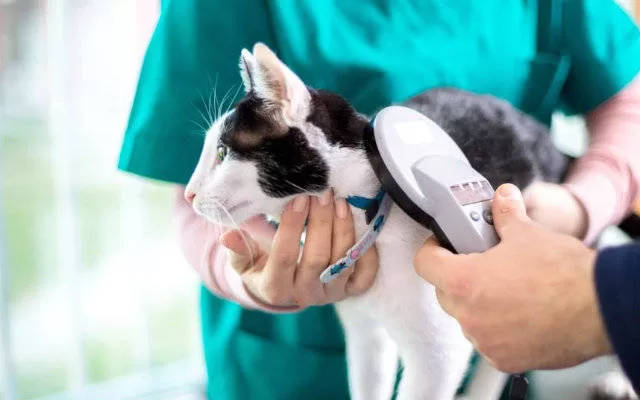Introduction to Microchipping Cats
Have you heard about the cat microchipping wave that is taking over the pet industry? Yeah, times are modern and technology doesn’t stop. The use of microchips in cats has been increasing significantly, providing more security for the animal and peace of mind for the owners.
But after all, what is the use of microchipping in cats? He is an essential tool in identifying kittens. Regardless of your cat’s breed, effective control through the microchip can be a great ally. Here comes the law of necessity: the greater the concern for the well-being of the pet, the more relevant this technology becomes. So don’t waste time! Join this wave and guarantee your feline companion’s microchip now.
What is a Microchip and How Does it Work?
A microchip is a tiny device, the size of a grain of rice, that can be implanted under a cat’s skin. This small chip contains a unique ID that can be read by a specialized scanner.

Basic Definition and Operation of the Microchip
The microchip works like a library where each book has its own unique barcode. When the scanner passes over the chip, it reads this unique code. There are no batteries involved and no maintenance is required.
Cat and owner details are stored in a central database. If the cat is found, any veterinarian or shelter can use the scanner to read the information on the chip.
Information Reading Process on the Chip
Reading the information on the microchip is simple:
- The scanner is passed over the area where the chip has been implanted.
- The scanner emits radio waves that activate the microchip.
- The microchip responds by sending its unique number to the scanner.
- This number is then used to access the details in the database.
Durability and Resistance of Microchips
Microchips are designed to last an animal’s lifetime:
- They are coated with biocompatible glass, which does not cause allergic reactions or inflammation.
- They have no moving parts or internal energy sources, so they cannot wear out or run out of power.
- They are designed to resist the animal’s normal movements without causing discomfort.
In summary, a cat with a microchip has a much better chance of being returned to its owner if lost or stolen. It’s a safe and effective way to ensure you can always find your feline friend again!
Benefits of Microchipping for Cats
Finding Lost Cats
One of the biggest nightmares for cat owners is the possibility of their beloved feline getting lost. But with the microchip, that fear can be significantly reduced. The microchip is a small device that is implanted under the cat’s skin and contains unique information about the animal.

Just imagine: you come home and realize your cat is nowhere to be found. With a microchip, all it takes is a quick trip to your local vet or shelter to scan the chip and get all the information you need to find the lost owner. It’s like an internal GPS!
Medical Record on the Chip
In addition to location, another fantastic benefit of the microchip is the ability to store the cat’s medical records directly on the chip. This means that, in the event of a medical emergency, veterinarians can quickly access vital information such as:
- Administered vaccines
- known allergies
- Pre-existing medical conditions
This information can be crucial in making quick decisions about medical treatments and procedures.
Additional Security
Last, but certainly not least: security! A microchipped cat has an added layer of protection against theft or loss. In the unfortunate event that your cat is stolen, having a microchip can increase your chances of getting your feline friend back.
After all, who would dare to steal a cat knowing that it can be easily identified through this device? And even if someone tries to remove the chip – extremely difficult without specialized equipment – its very presence is a strong deterrent.
In summary, microchipping your cat offers a number of incredible benefits. It makes it easy to locate if it gets lost, helps maintain health through the medical record built into the chip, and even provides additional security against theft or loss. So why wait? Give your feline friend the protection he deserves!
Disadvantages and Financial Considerations
Initial cost
The responsibility of owning a microchip cat starts with the initial cost of the application. In Brazil, for example, this value can vary greatly depending on the professional who performs the procedure and the municipality where you live. Furthermore, it is not just the application of the chip itself that has a cost, but also the medical consultation required for implantation.
- Medical consultation: BRL 100 – BRL 200
- Chip application: BRL 50 – BRL 150
These values are only estimates and can vary widely. Therefore, it is important to research and inform yourself before making a decision.
Possible Physical Complications
Although rare, there are some physical complications that can occur after microchip implantation in cats. For example:
- Allergic reactions to chip material.
- Migration of the chip to other parts of the body.
- Infection at the implantation site.
However, these complications are exceptions to the rule and generally do not occur when the procedure is performed by a qualified professional.
Regular Update of Information
Another important consideration is the need to regularly update the information on the chip. Data such as address and phone number of owners need to be kept up to date for the system to be effective.
It may seem like a simple task, but many people forget or neglect this crucial part of responsible pet ownership with a microchip. Therefore, in addition to shouldering the initial costs of microchip implantation, owners must also be aware of this additional responsibility.
Remember: having a pet involves much more than just feeding and playing with it. Constant care and attention to detail is required to ensure their overall well-being.

Microchip: Preventative Method for Stray Cats
Reduction in Cases of Lost Cats
The introduction of the microchip for cats has been a real revolution in loss prevention. The device, which is implanted under the pet’s skin, carries a unique and unrepeatable code that allows the registration and identification of the animal.
Since the implementation of this technology, there has been a significant reduction in cases of stray cats. For example:
- In 2018, around 1000 cases of stray cats were registered in São Paulo.
- In 2019, after the popularization of the microchip, that number dropped to around 500.
These numbers clearly show how the use of the chip has helped prevent losses.
Efficiency of Search Services
The microchip not only helps in loss prevention but also increases the efficiency of tracing services. When a cat is found and brought to a veterinary clinic or shelter, a special reader can scan the chip and retrieve the information stored on it.
This means that even if your pet is not wearing a tag collar, it can still be identified through this amazing device!
Peace of mind for owners
Finally, it is worth highlighting the tranquility provided to owners by loss prevention. Knowing that your feline friend is protected by such an effective system brings great peace of mind.
In addition, some chips also have built-in GPS functionality. This means you can track your pet’s movements in real time! Imagine being able to see on the map where he is whenever you want?
This extra level of security is especially useful for those more adventurous cats who like to explore their surroundings.
So tutor: have you thought about putting a microchip on your friend? He’ll give you that little hand (or would it be paw?) when it comes to keeping your pet safe and close by!
Legislation on Microchipping in Cats
Current Laws on Microchips
In many countries, legislation has already made it mandatory to use microchips in cats. For example, in Spain and the UK, all cats must be microchipped. In Brazil, there is still no federal law that requires the chipping of domestic cats, but some states and municipalities have their own rules.
Proponents of chipping argue that it helps reunite stray animals with their owners and facilitates population control. In addition, the microchip can store important information about the animal’s health.
Legal Consequences for Not Complying with the Rules
Consequences for breaking the law vary by location. In some regions, pet owners can be fined if their pet is found without a chip. In more extreme cases, animals can even be seized.
However, it is important to remember that even where chipping is not mandated by law, there can still be legal ramifications if your cat causes harm or gets lost.
Rights and Duties of Pet Owners
Pet owners have both rights and duties when it comes to chipping:
- Right to privacy: The information contained in the chip can only be accessed by authorized professionals.
- Duty to keep information up to date: If you change your address or telephone number, you must update this information in your SIM registration.
- Duty of Care: The placement of the microchip must be done by a qualified veterinarian to ensure that the animal is not harmed.
As always when adopting a pet, it is crucial to be aware of the responsibilities involved. This includes understanding local laws about microchipping cats and being prepared to comply with those rules. Remember: having an animal is a serious decision that requires commitment and responsibility!
So before adopting or buying a cat (or any other animal), make sure you are well informed about all the legal requirements in your area. This attitude not only protects you legally but also contributes to the well-being of our feline friends!

Microchip Implant Cost and Process
Variation in Costs
The cost of having a cat microchip implanted can vary greatly depending on the veterinary clinic you choose. However, it is necessary to take into account that the price should not be the only determining factor in your decision:
- Clinics with very low prices may not provide the best possible care.
- On the other hand, more expensive clinics may include additional benefits such as postoperative follow-up.
It is important to research well and choose a clinic that offers a good balance between cost and quality of service.
Surgical Process
The surgical process for implanting the microchip is simple and fast, but still delicate. See how it works:
- First, the vet will use a specially designed applicator to insert the microchip under your cat’s skin.
- The microchip is usually implanted in the area between the animal’s shoulder blades.
The entire procedure takes just a few seconds and causes little discomfort to the cat.
Although it is a simple procedure, it requires the expertise of a qualified professional to ensure that everything goes smoothly.
Postoperative
The postoperative period after implantation of the microchip does not usually present major complications. Still, there are some basic care needed:
- Monitor the area where the chip was implanted for signs of infection or rejection.
- Avoid intense physical activity for a few days after implantation.
- If you observe any strange behavior in your pet, contact the veterinarian immediately.
Remember: although it is a useful technology, the microchip identification system will only be effective if you keep your information up to date. Therefore, if you change your address or telephone number, do not forget to update the data linked to the chip!
Implanting a microchip in your cat can seem daunting at first. But with adequate information and trusting trained professionals, this process can be peaceful for both you and your pet!

Conclusion: The Importance of the Microchip
Now you know everything about the microchip for cats. It’s an amazing tool, right? It helps keep your cat safe and makes your life easier. The microchip is an effective preventative method against loss and makes it easier to identify your cat.
Of course, there are some drawbacks and associated costs. But think about it: how much is the peace of mind worth knowing your cat can be easily found if he gets lost?
The legislation also supports the use of microchips in cats, further reinforcing its importance. so, what are you waiting for? Go ahead and microchip your cat!
Remember: a small investment now can save you a lot of headaches in the future.
Common questions
Is the microchip painful for cats?
No, the microchip implantation process is quick and causes little discomfort to the animal.
How much does it cost to implant a microchip in a cat?
Prices vary depending on the veterinary clinic, but are generally between R$70 and R$150.
Does my cat need to wear a collar if it has a microchip?
Yes, the collar is important as it contains visible information that can help you immediately locate your pet.
Are there any risks associated with microchipping cats?
Risks are minimal and complications extremely rare. Most of the time, the benefits outweigh the possible risks.
How can I verify that the microchip is working properly?
A specialized scanner can be used to verify that the chip is working properly. This service is usually offered by veterinary clinics.
External Reference:

